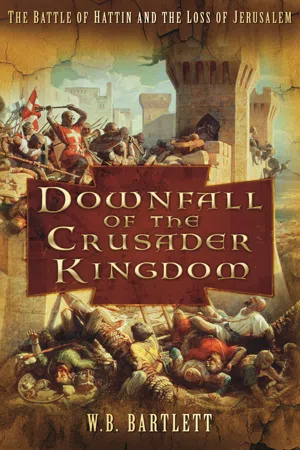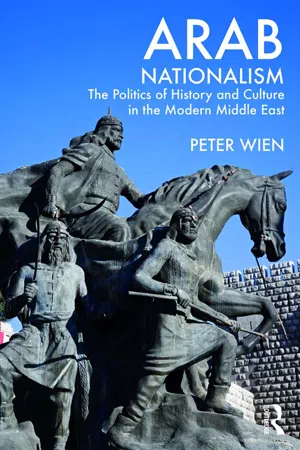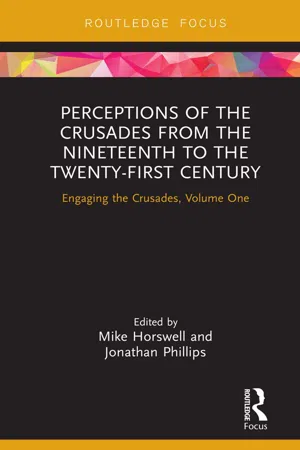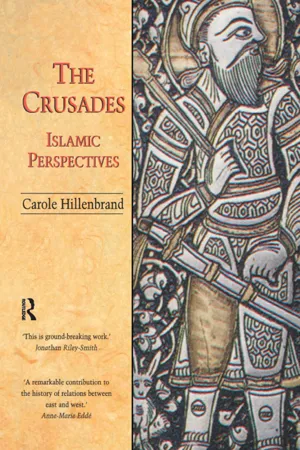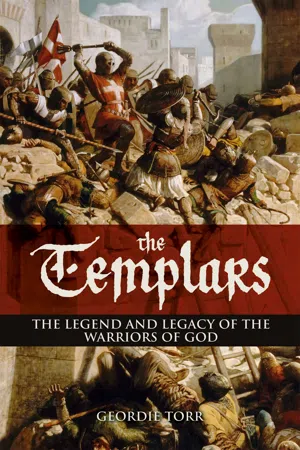History
Saladin
Saladin was a Muslim military leader and the first sultan of Egypt and Syria. He is best known for his role in the Crusades, particularly for his victory over the European Crusaders at the Battle of Hattin in 1187. Saladin's military prowess and his efforts to unite the Muslim world have made him a revered figure in Islamic history.
Written by Perlego with AI-assistance
Related key terms
6 Key excerpts on "Saladin"
- eBook - ePub
Downfall of the Crusader Kingdom
The Battle of Hattin and the Loss of Jerusalem
- W B Bartlett(Author)
- 2011(Publication Date)
- The History Press(Publisher)
It was Saladin’s good fortune to be the nephew of Shirkuh, a mighty warrior, much respected by Nur ed-Din. Shirkuh acted as Saladin’s mentor, giving him much of his early training in warfare and politics. In both fields, he would be a sound, if not always a brilliant, exponent. Militarily, Saladin was no Alexander and tasted the bitter pill of defeat on more than one occasion. Politically, he did not win everyone to his side: but in both fields he was a more than capable operator and in politics in particular he showed himself to be adroit at handling some difficult situations.What then would make Saladin great, a name so famous that, 800 years after his death, he is to the West perhaps the most famous of all Muslims from the past with the exception of the Prophet himself? There are two perspectives of Saladin. One, the Western view, is shaped around his confrontation with Richard the Lionheart. This is an encounter that became imbued with an almost mythical veneer, a story of great chivalry but one that also has layers of hyperbole obscuring the underlying truth. But it found a willing audience in the readers and listeners of Western Europe who thrilled to the accounts of the battles, intellectual and military, between the gracious and generous Islamic leader and the mighty warrior-king Richard.This is not the view that seized the imagination of the Islamic world. Here, Saladin was a warrior who fought himself to a standstill in the cause of his faith. The story has all the classic ingredients of a young, worldly man who later turned to religion to find greatness. In his early years, Saladin was headstrong, ruthless and ambitious. But then, late in life, he was the victim of a potentially terminal illness. As he hovered in the shadow lands between life and death he took a solemn vow that, should he recover, he would devote himself to the service of Allah. When the recovery was granted, he sought to make good his pledge.His timing was impeccable. His birth and meteoric rise coincided with a resurgence of the concept of jihad against the enemies of Islam in the Middle East. Such feelings had never gone away but the twelfth century had seen a re-emergence of the concept.2 - eBook - ePub
Arab Nationalism
The Politics of History and Culture in the Modern Middle East
- Peter Wien(Author)
- 2017(Publication Date)
- Routledge(Publisher)
6 According to the Islamic Enlightenment paradigm, neo-imperialism and the expansion of the world market spread these trends across the globe in the course of the nineteenth century, where they coincided with and fired up parallel worldwide intellectual developments. There, as much as in Europe, new models of reasoning created an epistemological shift that put the individual into a radically different environment of self-location than was ever before experienced: Man was called upon rather to make history than simply abide by the course of nature; tradition did not provide a blueprint for the solution of present problems. History, however, offered material for stories that could be told and re-told time and again to help man to reflect on the present.* * *Saladin – in Arabic, Salah al-Din – is one of the central heroes of Arab history, with particular relevance in the countries of the Fertile Crescent.7 There is an entire map of commemorative places stretching from the Cairo citadel, which is named after its founder Saladin, to an entire province in Iraq that bears his name because its capital, the town of Tikrit, is the Great Man’s birth place. In 1991, the Syrian propaganda apparatus issued a poster that showed a painting of charging horsemen, juxtaposed with a photo of President Hafiz al-Assad, under the headline “Min Hittin ila Tishrin” (“From Hittin to Tishrin”) drawing a line from Saladin’s epic victory at Hittin (today in Israel) over the Crusaders in 1187 to the October (Arabic: Tishrin) War in 1973.8 - eBook - ePub
Jinnah, Pakistan and Islamic Identity
The Search for Saladin
- Akbar Ahmed(Author)
- 2005(Publication Date)
- Routledge(Publisher)
Muslim heroes in history are sometimes men of ideas like Al-Beruni (in the tenth-eleventh century) and Ibn Khaldun (fourteenth-fifteenth century) but are usually men of action like Tariq, who conquered Spain in the eighth century, or Babar, who established the Mughal dynasty in sixteenth-century India. The heroes who are immortalized are those who combine Muslim tradition and a dramatic victory at a time of general crisis, such as Saladin.Saladin is the leader par excellence, as described in the preface to a popular book written by a Muslim author, Hundred Great Muslims: ‘Saladin the Great (Sultan Salahuddin Ayyubi)…was a symbol of Muslim unity and solidarity, piety and strength’ (J.Ahmed 1977 ). Contemporary Muslims everywhere look for Saladin, whether in Britain (Werbner 1990 :55) or in India (Kakar 1995 :221) or in the Arab world (see the article by David Hirst in the Guardian, ‘Divided Muslim peoples yearn for a new Saladin’, 12 December 1992); even Saddam Hussein exploited this yearning by encouraging his press to project him as another Saladin during the Gulf War.Among Muslims, Saladin’s name is synonymous with courage, compassion, integrity and respect for culture. My use of Saladin in the sociological imagination is not to be taken literally; it is a metaphor, a cultural construct, an ideal-type. In this manner an analogy can be made between Saladin and Jinnah.Saladin and Jinnah are both known in history for their victory—Saladin recapturing Jerusalem, Jinnah winning Pakistan. Although they are an unlikely pair, none the less they have much in common. Both were outsiders in mainstream Muslim society. Saladin was not an Arab in a world dominated by the Arabs and their language; indeed, he was a Kurd, a tribal people with their own culture and language. Jinnah did not belong to the culture of the United Provinces (UP) and Punjab which dominated the Muslims of India. He was from the Sind, originally Gujarat, and was a member of one of the minor sects within Islam. He did not speak Urdu, the main language of North India; nor did he dress or behave like those who lived in the UP and the Punjab. Both Saladin and Jinnah took on the most renowned opponents of their age, almost mythical in stature. Saladin fought against Richard the Lionheart and Jinnah challenged Mountbatten, Gandhi and Nehru. - eBook - ePub
Perceptions of the Crusades from the Nineteenth to the Twenty-First Century
Engaging the Crusades, Volume One
- Mike Horswell, Jonathan Phillips, Mike Horswell, Jonathan Phillips(Authors)
- 2018(Publication Date)
- Routledge(Publisher)
38 Alongside these references to the medieval sultan’s faith and justice, the multiple naval battles of the sixteenth and seventeenth centuries had a strong sense of a crusading enterprise and were certainly seen, by both sides, as being in a continuum with the earlier period.In 1878, Sultan Abdul Hamid II commissioned a marble cenotaph to stand next to Saladin’s thirteenth-century wooden tomb in his mausoleum in central Damascus. The Ottoman was clearly aware of the resonances borne by the medieval hero, and the inscription linked him to the Ayyubid ruler who defended his people and his faith against invaders. There was probably a need for Abdul Hamid to boost his image in Syria after defeat in the Russian-Turkish War of 1878 and to tie himself to this champion of the past. Equally, for him to judge this a worthwhile exercise he must have believed that Saladin had a sufficiently high profile in his own right to warrant making the connection. The cenotaph itself is of an Ottoman baroque style, a mark of modernity at the time, and it remains in situ today.39From the early 1880s the sultan, who, it must be remembered, was also the Sunni caliph, embraced the idea of Pan-Islamism as he sought to draw his people together against the influences and the incursions of the West. A powerful voice in this call was Jamal al-Din ‘al-Afghani’ (d.1897). The roots of his ‘interest in jihad and bitter opposition to the British’ came from his time in India in the 1850s and 1880s, although this did not prevent him from later spending time in London, Paris and many other European capitals; he also travelled extensively in the Muslim world. Al-Afghani is described as a ‘neo-traditionalist’ who wanted national and then (especially) Islamic precedents for the reform and advancement of society, change sometimes prompted by Western influences.40 A picture of the West as hostile and dismissive of the Muslims characterised his writing. Thus, a spirit that was seen as nationalistic and patriotic in Europe was, he argued, branded as fanaticism in the East; likewise, national pride in the West was seen as xenophobia in the Orient. He suggested that the Christian world, in spite of its divergence of races and nationalities, was united in a desire for the destruction of Muslim countries. He felt the crusades survived as if nothing had changed and argued that Muslim nations did not have the same rights as Christian ones in international law. Westerners claimed the alleged barbarity and backwardness of the Muslims as a justification for attacking and humiliating them when in fact they were smothering awakening and reform in the Muslim lands.41 - eBook - ePub
- Carole Hillenbrand(Author)
- 2018(Publication Date)
- Routledge(Publisher)
69 Certainly it is worth mentioning that, unlike Saladin, Nur al-Din did not have the obvious advantages of two contemporary image-makers to mould his career in the way they wished to present it. Ibn al-Athir, writing two generations or so later for the court circle of the successors of Nur al-Din, is the writer whose role most resembles that of a panegyrical biographer for Nur al-Din. Nevertheless, he is in some respects at a critical disadvantage because of the time lapse between himself and his subject.Saladin’s biographers, for their part, make it clear underneath their rhetoric that their master was, in their eyes at least, capable of inspiring great loyalty amongst his advisers and soldiers, many of whom would have given their lives for him, and their accounts of his charismatic personal qualities, chivalry and generosity are echoed in the Western Crusader chronicles, which lie outside the remit of this book. Together, they formed the basis of the legend of Saladin in later medieval Europe which the Muslims were eventually to reclaim as their own in the nineteenth and twentieth centuries. Saladin’s moral superiority over his contemporary peers, both Muslim and Christian, was acknowledged in his own lifetime by his enemies, the Crusaders; his image, even amidst the anti-Muslim bigotry of the European Middle Ages, remained unsullied, even romanticised, and that at a time when Europe’s attitude towards Islam was a sorry mixture of ignorance and hostility.As for Nur al-Din, he was deprived of the ultimate prize of Jerusalem. Without it his achievements remain less dramatic than those of Saladin; but it was through the career of Nur al-Din that the foundations of a fully-fledged jihad programme were established. Saladin would not have attained his successes had Nur al-Din not prepared the way.Confronted by the Crusaders, and by the ideological challenge which they represented, the Muslims of the twelfth century were able gradually to restore the notion of jihad - eBook - ePub
The Templars
The Legend and Legacy of the Warriors of God
- Geordie Torr(Author)
- 2020(Publication Date)
- Arcturus(Publisher)
Ralph of Diss, chronicling an eyewitness account, described the Templars’ charge thus: ‘Spurring all together, as one man, they made a charge, turning neither to the left nor to the right. Recognizing the battalion in which Saladin commanded many knights, they manfully approached it, immediately penetrated it, incessantly knocked down, scattered, struck and crushed. Saladin was smitten with admiration, seeing his men dispersed everywhere, everywhere turned in flight, everywhere given to the mouth of the sword.’Saladin only avoided capture by fleeing from the field of battle on a camel. Even before the Templars’ cavalry charge, many of his men had fled. When those who remained saw their leader escaping, the battle turned into a rout. By late afternoon, what was left of the Muslim army had taken flight, attempting to follow the sultan while pursued by the Christians, who followed them for some 12 miles (20 kilometres) until night fell. Only the arrival of nightfall stopped the battle turning into a complete massacre.Saladin and the surviving tenth of his army made their way back to Egypt across the Sinai Desert in pouring rain, harassed by Bedouin nomads, reaching Cairo ten days later on 8 December. Along the way, Saladin, who was worried about his hold on power, sent messengers on camels to inform Cairo that he was alive. Upon arrival, he ordered carrier pigeons to be dispersed far and wide with news of his return. The fact that Saladin was a Kurd rather than an Egyptian made his position as the Ayyubid sultan precarious. His popularity wasn’t helped by the fact that he had ruthlessly suppressed several rebellions in order to establish Sunni Muslim rule over Egypt’s Shia Muslim and Coptic Christian population. He was also unpopular in Syria, where he was viewed as a usurper who had stolen the sultanate from the rightful heir. Indeed, his control of Syria didn’t extend far from the capital – he had failed to take control of such key cities as Aleppo and Mosul, whose inhabitants remained loyal to Nur ad-Din’s son.For these reasons, Saladin’s conflict with the Crusader states was a welcome distraction, focusing people’s attention on an external enemy rather than on his apparent illegitimacy as ruler. And in truth, the Christians were a real threat. They could potentially cut off communication between Egypt and Syria and had invaded Egypt five times during the 1160s. To rally support, Saladin took up the cry of ‘jihad’ – holy war.
Index pages curate the most relevant extracts from our library of academic textbooks. They’ve been created using an in-house natural language model (NLM), each adding context and meaning to key research topics.
